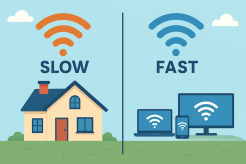How Fixed Wireless Technology Can Improve Rural Connectivity

Rural communities often face significant challenges when it comes to reliable internet access. Traditional broadband options like fiber or cable are not always feasible in these areas due to high infrastructure costs and challenging terrains. This is where fixed wireless technology comes into play, offering a practical and cost-effective solution to improve rural connectivity. In this blog post, we'll explore how fixed wireless technology works, its benefits, and why it could be the key to bridging the digital divide in rural areas.
Understanding Fixed Wireless Technology
Fixed wireless technology uses radio signals to deliver internet service to a fixed location, such as a home or business. Unlike mobile wireless services, which are designed for mobility, fixed wireless provides a stable and high-speed connection that is comparable to traditional wired broadband options.
To learn more about the technology behind fixed wireless, check out this comprehensive guide.
How Fixed Wireless Works
Fixed wireless internet relies on a network of base stations that transmit signals to receivers installed at the customer's location. The receiver, usually a small dish or antenna, communicates with the base station to provide internet access. Since it doesn't require extensive cabling, fixed wireless can be deployed quickly and at a lower cost, making it an ideal solution for rural areas.
Benefits of Fixed Wireless for Rural Areas
1. Cost-Effective Deployment
One of the biggest advantages of fixed wireless technology is its cost-effectiveness. Traditional broadband requires extensive infrastructure, including laying cables underground or installing telephone lines, which can be prohibitively expensive in rural areas. Fixed wireless, on the other hand, requires minimal infrastructure, making it more affordable to deploy.
2. High-Speed Connectivity
Fixed wireless technology can deliver high-speed internet, comparable to that of cable or DSL, making it a viable option for users who need reliable and fast connections. Whether it's for streaming, video conferencing, or online learning, fixed wireless can meet the demands of modern internet users in rural areas.
3. Quick Installation
Since fixed wireless technology doesn't require extensive cabling, it can be installed quickly. This is particularly beneficial for rural communities where residents have had to wait for years for reliable broadband. With fixed wireless, installation can be completed in a matter of days, bringing connectivity to underserved areas swiftly.
Comparing Fixed Wireless with Other Internet Services
Fixed wireless is just one of several options available for internet connectivity. It's important to understand how it compares to other services like satellite, DSL, and fiber. Each has its own advantages and disadvantages, but fixed wireless stands out in rural areas due to its balance of cost, speed, and reliability.
For a deeper dive into the different types of internet services available, you might find this article helpful.
Best Fixed Wireless Internet Service Providers
When considering fixed wireless internet, it's essential to choose the right provider. The best providers offer reliable service, competitive pricing, and excellent customer support. If you're in the market for fixed wireless internet, this guide to the best providers can help you make an informed decision.
Challenges of Fixed Wireless in Rural Areas
While fixed wireless offers many benefits, it's not without its challenges. The technology relies on line-of-sight between the base station and the receiver, which can be obstructed by natural features like hills, trees, and buildings. Additionally, weather conditions can affect signal strength, potentially leading to interruptions in service. However, ongoing advancements in technology are helping to mitigate these issues, making fixed wireless an increasingly reliable option for rural areas.
Setting Up a Fixed Wireless Network at Home
If you're considering fixed wireless as your internet solution, setting up your home network is straightforward. Most providers will handle the installation of the receiver, but setting up your Wi-Fi network is something you'll likely do yourself. For a step-by-step guide on setting up your home Wi-Fi network, take a look at this helpful resource.
The Future of Rural Connectivity
As technology continues to evolve, fixed wireless is likely to play an increasingly important role in bridging the digital divide in rural areas. With ongoing improvements in speed, reliability, and coverage, fixed wireless could soon become the go-to solution for rural communities that have long been underserved by traditional broadband options.
Conclusion
Fixed wireless technology offers a promising solution to the connectivity challenges faced by rural areas. Its cost-effectiveness, high-speed capabilities, and quick installation make it an ideal option for communities that have been left behind by traditional broadband services. As rural connectivity becomes more critical than ever, fixed wireless stands out as a viable path forward, ensuring that everyone, regardless of location, has access to the digital world.
Related Posts

Fri, Dec 19, 2025 4:36 AM
SafetyEasy Ways to Keep Your Video Calls Secure
Learn practical ways to secure your video conferencing apps and protect your calls from unwanted access, cyberattacks, and privacy risks.

Fri, Dec 19, 2025 2:39 AM
Internet Bundles Broadband Deals TechnologyWhy Internet Bills Keep Going Up (And Why It Feels Constant)
Why do internet bills keep rising? Learn how ISP fees, limited competition, and pricing strategies quietly increase broadband costs.

Thu, Dec 18, 2025 3:59 AM
cheap internet dealsViasat (Exede) Satellite Internet Plans & Pricings
Explore Viasat (Exede) satellite internet plans, pricing, and speeds. Learn about availability, equipment, technology, and tips for rural and remote areas.

Thu, Dec 18, 2025 2:14 AM
SafetySimple Online Safety Tips Anyone Can Follow
Learn simple, practical ways to stay safe online—even if you’re not tech-savvy. Protect your data, avoid scams, and improve digital security with easy habits.

Wed, Dec 17, 2025 2:22 AM
WifiWhy’s My Internet Slower Than What I’m Paying For?
Paying for fast internet but getting slow speeds? Learn the real reasons your internet doesn’t match your plan and how to fix performance issues.